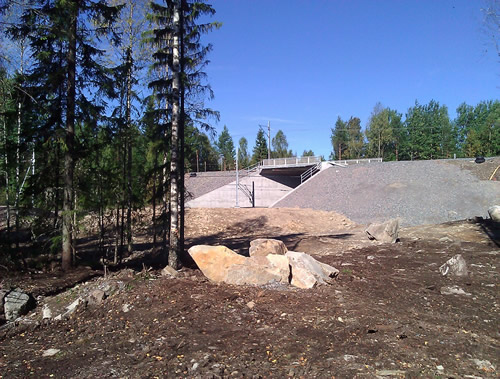TGOJ-porten |
|
Construction Only Award
Project Team
Client: Trafikverket
Design: Skanska Sverige AB
Construction: Skanska Sverige AB
The Project
Skanska was contracted by Trafikverket (the Swedish Transport Administration) to replace a railway bridge for rail traffic in two levels. The purpose of the replacement was to increase the traffic flow and accessibility in the area. Since the supportive structures to the old bridge were judged to be weak, the old steel bridge was replaced by a concrete bridge. The bridge was constructed within the area, beside the railway and launched into position, reducing interruptions to railway traffic. The project started in November 2011 and finished in October 2012, and the contract sum was estimated at 19.8 million SEK. It was decided by the contractor Skanska, to aim for a CEEQUAL Award.
Construction of the bridge
Challenges faced:
Material Use
In order to lower the need for procurement and the transport of virgin materials, the existing structures within the project were efficiently re-used within the site. The existing bridge foundation was not suitable to be re-used for the same purpose, but was instead crushed and re-used as supportive material for the new construction.
The aggregates brought in to site were beneficially re-used within the area during the different phases of the project. This resulted in an approximate 30% reduction in the need for virgin materials. Further planning was done to re-use materials (e.g. railway sleepers) and structures within the project.
Land use & Landscape issues
Different alternatives for the launch of the new bridge were evaluated to reduce the amount of land needed, in addition to significantly reducing the land area, a smaller area of forest was cleared.
Launching of the bridge
All on-site soil was temporarily taken aside during construction, but it was reused on site after construction had finished.
Effects on neighbours and water resources
The project was located in a fairly remote area so there was no direct risk of disturbance or noise impacts during construction. The location and the size of the site area required logistical planning in terms of material deliveries and other transport related issues, which were well managed. Due to the location of the project the use of potable water was very low.

The site area
CEEQUAL influence:
The ambition to increase the sustainability of the project was high from the beginning and CEEQUAL highlighted and pushed the sustainability issues even further. Using CEEQUAL, increased perspectives and allowed for questions to be raised at an earlier stage and evaluated in more depth. This allowed the team to assess the impacts of the project and subsequently decide earlier what actions could be taken to reduce these impacts. Alternative methods were raised and evaluated during the project, which led to more people being involved in sustainability discussions; which increased general understanding of what impacts the project may have and how they could be reduced.

The finished bridge

